
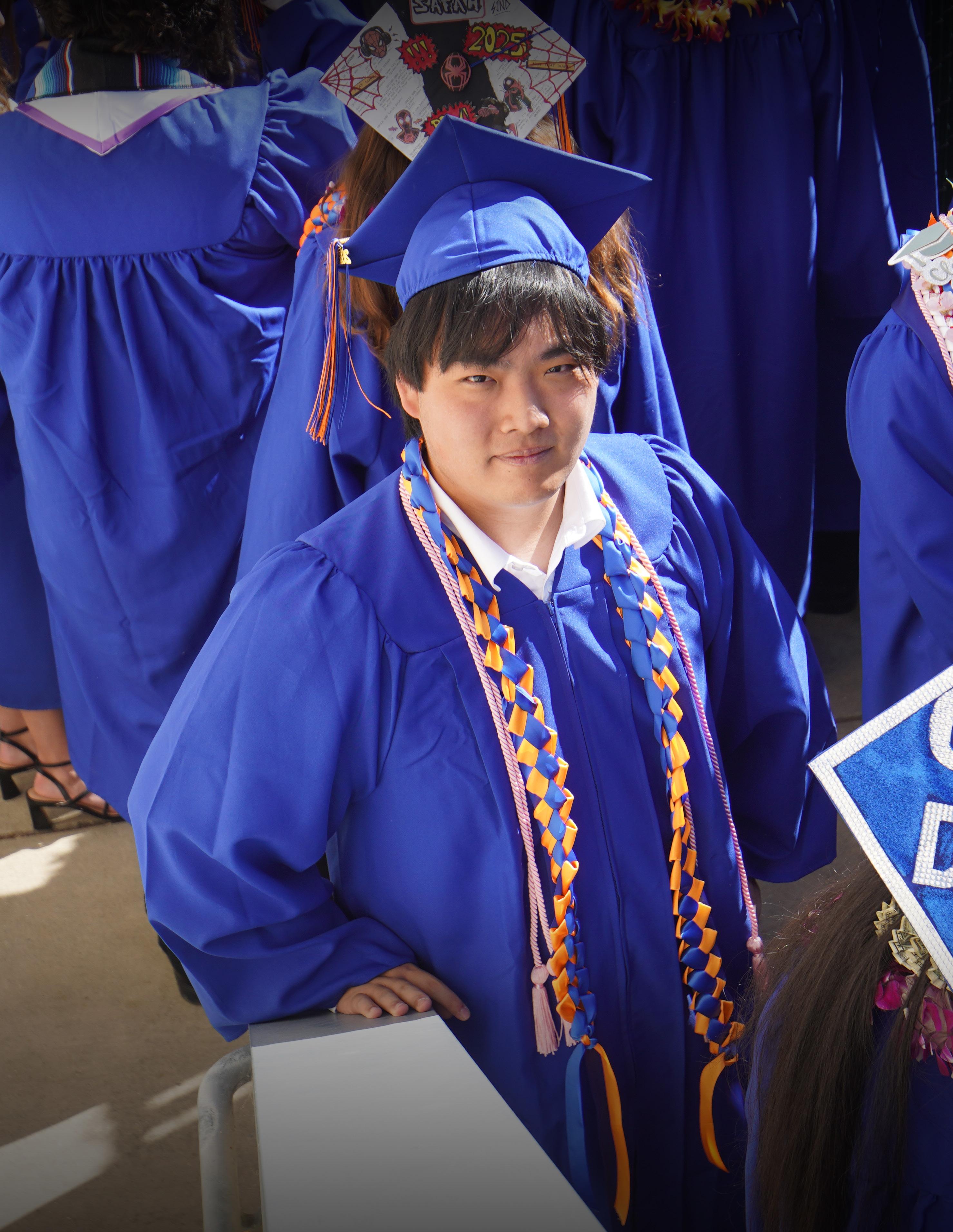



Principal
Fr. Steve Kim
Director of Development
Eileen Greybeal
Writer
Colette Gunn-Graffy
Designer
Giullian Galindo ‘20
Mission Statement
Saint Joseph Notre Dame, a Catholic parish high school, provides a dynamic and rigorous college preparatory education. Our faith-filled, diverse, and welcoming community embraces the teachings of Jesus Christ. We develop confident, open-minded, and effective leaders who are ready to live joyful lives of faith, scholarship, and service.
Vision Statement
SJND will continue to expand innovative pathways that enable students to learn, engage, serve, and live confidently in pursuit of opportunities to become their best selves.

Views expressed do not necessarily reflect those of the editors, SJND or the Oakland Diocese.
Page 3
From the Principal
Page 4
From Development
Page 5-8
Highlights
Page 9
Know Your Audience
Page 10
Student Perspectives
Page 11
Basketball in the Phillippines
Page 12-18
6 Students and Their Journey to Graduation
Page 19
SJND Mentorship Program
Pages 20-22
SJND Students Create a Digital Game to Share in Shanghai
Page 23
Alums Return to Recruit a New Generation of Pilots
Pages 24 & 25
Then & Now: The SJND Uniform
Pages 26-28
John Gunty Ends an Era at SJND
Pages 29 & 30
The Vocation Journey of Fr. Álvaro Santamaría
Page 31
The SJND Future Fund
Pages 32 & 33
Cathy Fitzgerald Retires from SJND
Page 34
In Memoriam

Thank you for your continued interest and support for our SJND community. Year after year, we continue to focus on our school’s mission to develop confident, open-minded, and effective leaders ready to live joyful lives of faith, scholarship, and service.
We developed the acronym:
D: Dedicated to service
This year, we focus on our dedication to service. Whether it’s serving our friends, the school, a local community, or those in need, service is crucial to our journey. This year, I had the opportunity to teach a dual enrollment class for our students through the College of Alameda. The class focused on the skills of Catholic entrepreneurship and asked students to consider four fundamental questions:
What do I love doing?
What am I good at?
What does the world need? How can I get paid?
Most people focus on getting paid; it doesn’t matter if they like the job or whether it makes a difference to serve others. However, a Catholic entrepreneurial spirit focuses on solving a problem in the world to provide a gain to someone’s pain.
This is the essence of a Catholic education: educating the whole person to prepare students to be successful on earth in a variety of ways — and, ultimately, be citizens in heaven. I hope the articles in this magazine help highlight our journey to raise the bar and be of service to others. Blessings and thank you for your continued partnership in serving our SJND community. Go Pilots!
Sincerely,

Fr. Steve Kim Principal

It is an honor to serve as the Development Director for Saint Joseph Notre Dame High School, a place where dedication to academic excellence and character development truly sets us apart. I am deeply proud to be part of a community that values both tradition and innovation, and where every gift, of time, talent, or treasure, helps shape a brighter future for our students.
Our goal in the Development Office is clear: to build strong partnerships and grow support that sustains and strengthens our school’s mission. In the year ahead, we will continue to focus on outreach, inviting more families, alumni,
and community members to engage in our shared vision.
Whether through annual giving, special events, or long-term initiatives, every contribution plays a vital role. I look forward to connecting with you and working together to ensure that our students continue to thrive in an environment that challenges, nurtures, and inspires.
Thank you for your support and for being an essential part of this journey.
Warmly, Eileen Graybeal Development Director
We’re proud to share that SJND, in collaboration with the Basilica, participated in this year’s 4th of July Parade, and brought home 3rd place in the Live Music Division! It was a wonderful display of teamwork, spirit, and talent. A big thank you to all the students, faculty, staff, and community members who helped make it happen. What a great way to celebrate Independence Day!





This past April, 13 SJND students and 2 faculty traveled to Costa Rica and Panama for a 12-day cultural immersion experience that included stays in San José and Puerto Limón in Costa Rica, and Boquete and Panama City in Panama.
In addition to enjoying the natural environment through ziplining, kayaking, surfing, and hiking excursions, the group toured historical sites and spent time with the indigenous Bribri people. Both students and faculty were moved by the incredible sense of community that they experienced as locals welcomed them into their homes, ate with them, and taught them how to make chocolate.
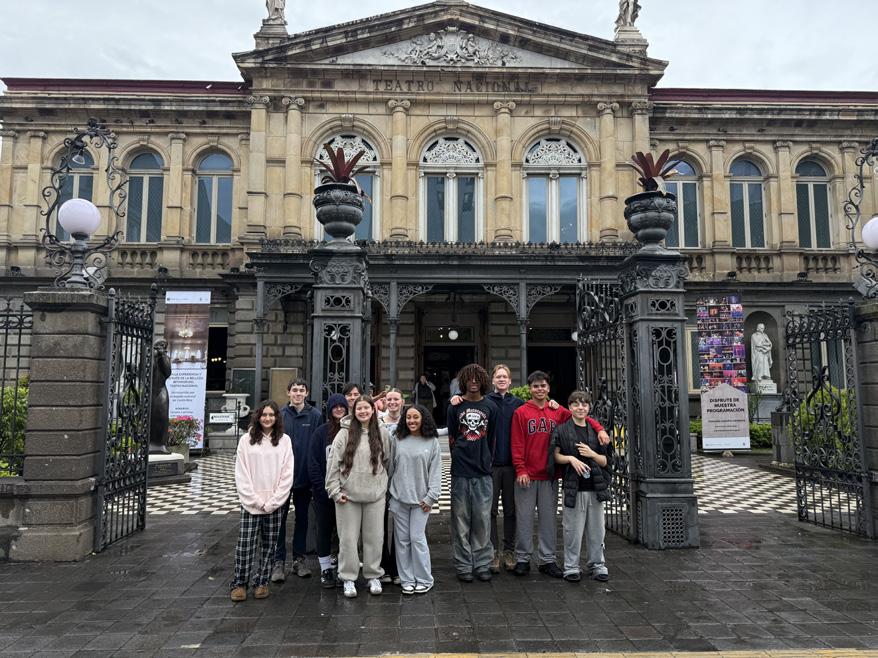
Through the trip, participants learned basic Spanish, as well as the history of these countries and their people. Many students were so inspired by their experiences that they have begun researching volunteering opportunities in the area in the hopes that they can return at some point.
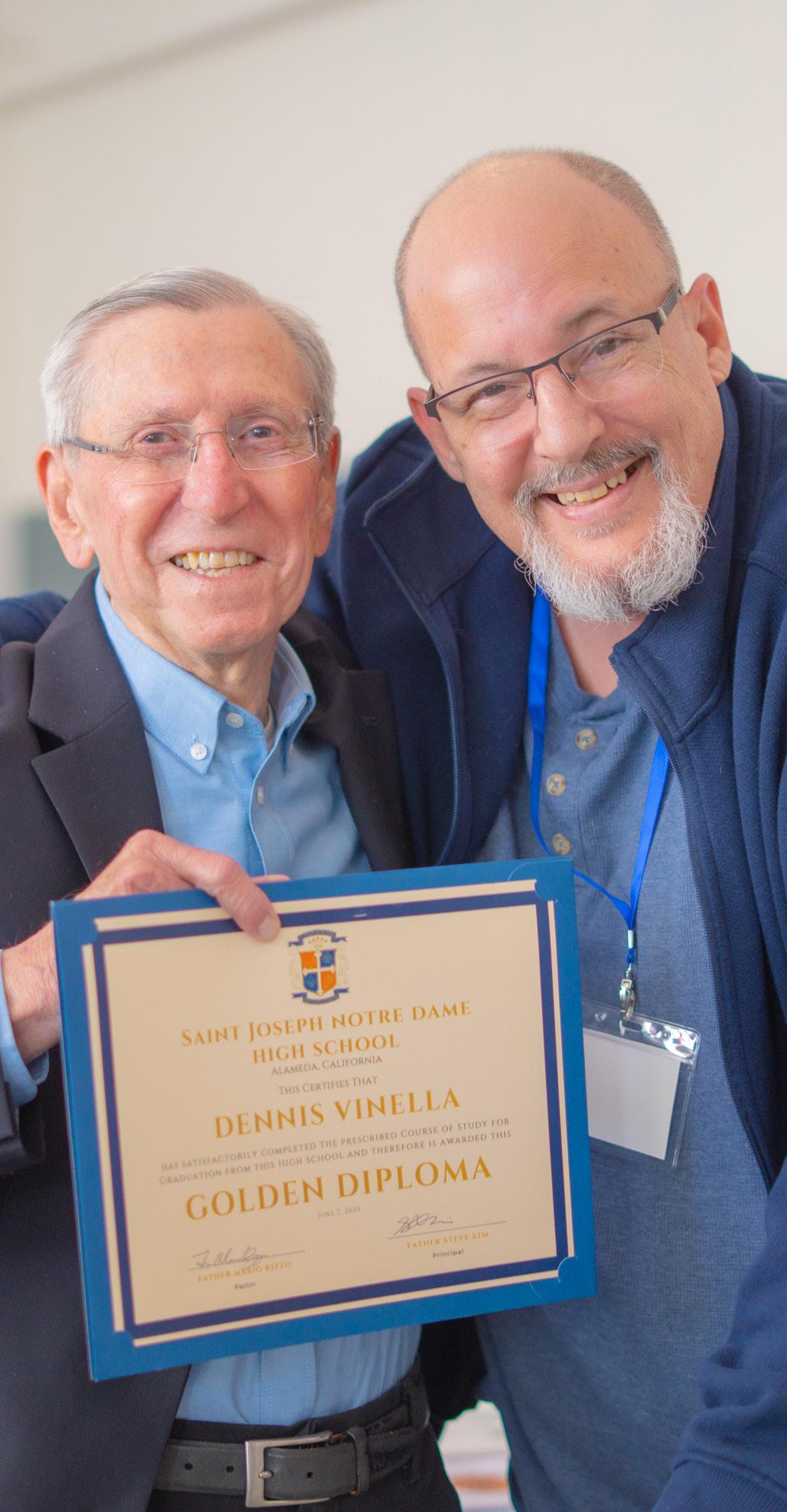

On June 7th, SJND hosted a Golden Reunion to celebrate the class of 1975, who graduated from what was then two separate schools, St. Joseph’s Boys High School and Notre Dame Girls High School. 25 members of the class attended, along with partners and spouses. Former Principal Tony Aiello, former Vice Principal Phil Gravem, and former boys basketball coach Bob Sickenger were also in attendance.
The celebration began with a mass, the theme of which was “Jubilee: All is Forgiven.” At the reception that followed, the mass’s theme inspired much hilarity as members of the class of 1975 “owned up” to their misbehaviors as students. They also reminisced about what it was like to grow up at this moment in history: surrounded by peace protests, not needing calculators to do arithmetic, and trying to avoid the “wrath” of the strict nuns who ran the girls school.
The reception’s taco bar was also nostalgic: a reminder of the time when students had no cafeteria or food service, but would instead buy food from a street taco truck that would pull up outside the school during lunchtime.
The Varsity Girls Volleyball team made history this year, qualifying to bump up to Division 3 from Division 5 and competing in the state semi-finals: a first for SJND. Although the team did not advance to the finals, its members stood out to faculty, coaches, and other league players as disciplined and focused. According to Ashlee Robinson, Director of Athletics, these young women “embody what it means to be a scholar athlete”; not only do they balance athletics with academics, but they are also leaders within their school community, hyping up their supporters and working together on the court.
This year, the Varsity Boys Basketball team also experienced success, breaking out of a six-year hiatus to qualify for NCS. Additionally, the Junior Varsity team had a spectacularly strong season (19-1); next year, those players will transition to Varsity, bringing that energy and camaraderie to the new team.

The SJND Visual and Performing Arts (VAPA) Pathway is a new offering for students who want to develop their skills in and appreciation for the creative arts. The fouryear program allows for concentrations in Visual/Digital Arts, Band, Choir, and Musical Theater. Students can either devote all four years to a single concentration or devote three years to one concentration and an additional year to a second concentration.
One of the most valuable outcomes of this pathway is its emphasis on collaboration across disciplines to foster team-building and problem-solving. In addition to the rigorous requirement that students maintain an 87% GPA in their VAPA coursework, they are also expected to maintain membership in a VAPA-related honors society for two years, hold leadership positions in VAPArelated clubs or classes, and complete a capstone project in their senior year.


“In the classes I teach, students learn that considering your audience is more than just a “selling” tactic; it’s a way to be heard. In a world of increasingly great divides, a human being can still be a bridge.”
“Know your audience” is probably the most hackneyed piece of writing advice after “write what you know.” And yet, the wisdom behind both phrases can’t be dismissed.
As a teacher, my experience has taught me that students produce their best work when they not only write about what they know and care about, but also when they have a clearly defined understanding of their audience — in particular, the values and experiences of the people they are trying to connect with.
This latest edition of Update has been a collaborative effort between writer and English Department Chair Colette Gunn-Graffy (myself!) and graphic designer Giullian Galindo ‘20. In putting it together, we have been excited not just to share our talents, but also our knowledge and understanding of the SJND community and the stories that continue to resonate with this audience.
For Giullian, “the ability to shine a light on the things that are special to me” is one of the things he enjoys most about being a designer. Like many of the members of the community profiled in this edition, he didn’t set out knowing exactly where his path would lead, but by being open to the opportunities presented to him through the advertising major at the University of Oregon, internships, and student groups, he found his way to where he is now, designing the visuals and layout for Update.
As a recent graduate, Giullian explains, “I have a sense of what our alumni would like to see. I’m still
connected to many of the people this magazine will reach, and as an alum myself, I love seeing the cool and exciting things SJND students and faculty are doing.” Every design choice is an opportunity to highlight something about the school “in a way that will resonate with other alumni and help them feel connected to the community.”
I feel similarly. As AI-assisted (and generated) writing becomes more common, it’s easy to forget that at the heart of communication is an attempt at connection between human beings. Update is our attempt to connect. The choices I’ve made as a writer in this magazine, from featured topics to the words and details that help to bring them to life, stem from my decade-long absorption of the values and spirit that are at the heart of the SJND community. It’s my hope that the contents of this magazine not only demonstrate the ways in which the school is evolving to meet the particular challenges of our times, but also how, at its core, SJND is still a school that its alumni can relate to.
The essay that follows is an example of this: as Ariana Daya ‘27 laments the state of education for her generation, she is also championing the creativity and critical thinking that are hallmarks of adolescent rebels and lifelong learners in every decade.
In the classes I teach, students learn that considering your audience is more than just a “selling” tactic; it’s a way to be heard. In a world of increasingly great divides, a human being can still be a bridge.
We intend for “Student Perspectives” to become a regular feature of Update, bridging generations through student-produced writing.
This essay was written as part of the Honors Cultural Perspectives & Identity (Honors English 10) curriculum. Students researched a topic they were passionate about and used their research to craft an argument for a particular audience. They refined their argument over multiple drafts, thinking about the language and evidence that would most appeal to their audience, and editing it to meet a specific word count. Students who were able to limit their essays to 500 words or under also submitted them to the Open Letter Contest sponsored by The New York Times.

By Ariana Daya ‘27
It’s about time we realize the truth—standard American schooling has become an academically unhealthy space and has changed the way kids feel about learning. Feeling overwhelmed with an immense workload, fatigued in class, or battling clouds of anxiety with SATs right around the corner has become commonplace to the average student. American education has largely failed by preserving a military-like learning model of success that, while efficient, has sacrificed the emotional and creative health of its students. It is true that the system we practice today is so methodical that it instills a strict work ethic and sense of blind obedience into kids, but this is by no means the best way for them to acquire the life skills and knowledge necessary to succeed in life. We must take the steps to repair this prison-like system by broadening our curriculum to nurture student passions and by teaching students to use creative intuition rather than analytical thinking.
One of the main issues with education is that it follows a purely linear idea of learning and achievement. The whole process of teaching is an industrial procedure where kids are expected to get specific academic results by treating them all the same, instead of an organic process that takes time to assess and accommodate student needs. Essentially, kids today are not “taught” but “told.” Testing and memorization culture are both a part of this poisonous practice. As a student myself, I have observed firsthand the learning skills we are taught to use foremost—a combination of analytical and shallow thinking to probe for one “correct” answer to rapid-fire questions. Such methods will only ever give us hasty understanding. What if instead we taught our students to use explorational thinking that considers a diverse set of conclusions, or allowed them the time and aid to really cement their understanding? By teaching them divergent thinking, we will not only be best preparing students for their futures, but we will also provide them with an intellectual freedom that instantly replenishes their love for learning and for school.
It is much too common that we forget that the main mission of education is not just to produce well-learned students but also to foster talents and affinities and provide the encouragement to turn passions into careers. Being able to do what we love is what ensures our satisfaction in life, and education should be the engine that turns our dreams into reality. Creativity expert Sir Ken Robinson wholly endorses this idea. In his famous 2010 Ted Talk Robinson says, “Human resources are like natural resources, they’re often buried deep... you have to create the circumstances where they show themselves.” But the type of academic order we have, constantly fails to unearth these “natural resources.” It dislocates people from the talents they already have and refuses to give them the tools they need individually to best succeed. On top of that, we are not even covering all the bases because our curriculums are vastly unbalanced. While the STEM fields have weighty representation in school, important core subjects like the Arts, Physical Education, and even English are being sidelined. Reintroducing these subjects along with other tactics for personalized learning is how we pique curiosity so that students are prepared when they must decide their fields of interest and vocations.
There is no perfect plan for education and no model that guarantees the success of every child in college and in life. But we can do much better. The system in place today is pragmatic enough to be problematic, teaching us the wrong things in the wrong way. The results are nothing more than cookie-cutter members of society who have been so underestimated they will never contribute as much as they possibly can to the world. School environments have grown toxic amid a culture of uniformity and academic competition. The way we can move forward is by reinvesting in the areas and people where it matters most, which will change the values of education to be equitable and supportive. Education should never be a burden on the shoulders of students and teachers. It should be a vehicle for change and prosperity and a promise for the future.
This past spring, Amari Toldon ‘25 and Jaiden Pesino ‘26 spent two weeks playing basketball in the Philippines as part of a tournament hosted by Fil-Am Nation.
The mission of Fil-Am Nation is to bring greater visibility to Filipino-American athletes and aid them in being scouted or even playing professionally in the Philippines. Amari and Jaiden, along with 18 other teenagers, were selected to represent Fil-Am San Francisco in a tournament called “Manilla Live,” in which they played teams from all over the world, as well as local Filipino teams.

Both students were impressed with how quickly they built up chemistry with their teams, despite having only just met the other players. Asked if they would do it again, they responded, “Definitely!”








Four years ago, Jerry Hu ‘25 left his family in Dongguan, China to enroll as a freshman at SJND. Already a world traveler, Jerry was drawn to the U.S. because it was made up of so many different cultures. “I thought it would be interesting to study here,” he says with a smile.
Yet, being away from home was more difficult than Jerry had anticipated. Living with a host family could be lonely; Jerry missed his parents and sister. And unfortunately, Jerry had also started high school a few months late, when it seemed like all the other students had already formed their friendships.
Even though his English language skills were very good, Jerry often felt he couldn’t fit in: “Culturally, I didn’t have a lot that I could share [that my peers would relate to] when I first came here.”
However, Jerry persevered and eventually, in his junior year, things shifted. For one thing, he joined Mr. Sunderland’s Chess Club, which helped him make friends with others who shared his interest. But also, as he became more familiar with the school and its community, it became easier to connect with others. “It was very magical,” he says. “After a couple of years, I had more of a basis for conversation with people.”
Jerry also came to appreciate the way religion — a subject that he had previously disregarded
“I feel like I’m another person. I’ve become more mature. I’ve dealt with friendships and relationships alongside classes. I think I have more life skills:”
— supports people and creates community. He was particularly inspired after witnessing one of his teachers recover from a personal tragedy, claiming, “She helped me to believe in religion, and I think that her belief helped her to get through this hardship.”
Having overcome his own challenges as an international student, Jerry is looking forward to attending UC Davis in the fall, where he hopes to major in statistics and eventually go to graduate school.
When he thinks back to his freshman year, Jerry says, “I feel like I’m another person. I’ve become more mature. I’ve dealt with friendships and relationships alongside classes. I think I have more life skills: I learned to cook a lot of different Chinese food on TikTok! I’ve also had to handle things like identity documents and bank accounts all on my own. [Compared to other people] I’m much more independent and prepared for college.”

Carrie Truong ‘25 is passionate about medical research, which she attributes, at least in part, to her experiences at SJND.
After attending Saint Joseph Elementary School, Carrie arrived at SJND eager to pursue a number of interests, but unsure where they might lead career-wise. Embarking on the SJND biomedical pathway, however, allowed her to “take a deeper look at what the body does”, offering the focus and direction she needed.
As Carrie explains, “It can be overwhelming trying to pick [what classes] you have to take… but the class requirements of the biomed pathway help [you] to figure out your schedule. Having unique classes tailored to the program helps to further your interest in the subject.”
For her biomedical research project, Carrie examined the effects of propofol (an anesthetic) on blood pressure in the human body. She found it exciting to be able to explore something so novel and began to look for further opportunities to do research outside of school.
After sending off “a lot of emails” to various labs, Carrie eventually secured a position at the Frock Lab, part of the Stanford School of Medicine. Through her work with the Frock, Carrie contributes to research on genomics (the study of the genome and the
variety of ways genes interact with each other and the environment) in relation to cancer radiation therapy. Over the past two years, she has filled a hybrid role: “The lab provides me with sequences and spreadsheets to analyze … on my own time. I meet with my supervisor every two weeks to go over my analysis.”
In addition to her medical research, Carrie also spent much of her time at SJND honing her advocacy skills through her role on the speech and debate team. As Carrie puts it,
“I’d always been interested in healthcare … not just the human body [but also] the healthcare system.
“I grew up in a Vietnamesespeaking immigrant household and saw how difficult it could be to access and navigate the system when there are language and cultural barriers. It opened my eyes to medical inequity.”
… Speech and debate taught me how to convey [these sorts of] important messages to larger audiences and make sure that my voice was heard.”
This fall, Carrie will be attending Harvard University, where she hopes to study applied molecular and cellular biology, with government as her potential second choice.
When Landon Crevani ‘25 “landed” as a Pilot at the beginning of his freshman year, he figured he knew what he was in for. Not only had he graduated from Saint Joseph Elementary School, but his father, Michael Crevani ‘95, and older sister, Anekaila ‘16, were both SJND alums.
At one point, wanting to break out of the “bubble”, Landon considered transferring high schools to try a new environment, but at the last minute decided not to, a choice he is “very glad” he made. Looking back at freshman year, Landon is quick to acknowledge that he worried too much about what other people thought of him. “Now, I recognize who I am,” he asserts, “I’m very grateful for my first world problems, [for example] that I’m not worrying about having enough to eat. … I don’t have a clear answer [for my career path], but I know what I want to do. I want to help people. No matter what I find myself doing, … I want to give back to the world that has given me so much.”

One of the ways that Landon has given back at SJND is through the podcast “Sports Talk,” which he co-created with Greyson Martin ‘25 and Eduardo Cornejo ‘25 during their junior year. Initially, “Sports Talk” was just a club for people to show up and talk about professional sports, but according to Landon, “It got stale, and people would get too conflicted and yell at each other. I got the idea for a podcast so we could have a more organized discussion.”
Last year, “Sports Talk” was hosted on the Pilot Island channel, but this year it had its own YouTube channel. According to Landon, one of the primary goals of “Sports Talk” is to “give a shout-out to people who play sports at SJND in a way that we’ve never really had. It was about celebrating people [who wouldn’t necessarily receive that attention.] I want to ‘give people their flowers.’”
“I don’t have a clear answer [for my career path], but I know what I want to do. I want to help people. No matter what I find myself doing, … I want to give back to the world that has given me so much.”
This fall, Landon will be attending CSU Long Beach to study finance. Although he’s not entirely sure what the future holds, his time at SJND has inspired him: “I got to live in a bubble, and go to private school from Kindergarten to 12th grade. ... If I can help one person, and help put them in a position to help someone else … then that is my purpose.”

It’s no secret that Amanda Wheeler ‘25 loves to sail. It’s been her passion since the age of 7 when she joined the Junior Program at Richmond Yacht Club. As her skills progressed, Amanda joined the club’s Youth Racing Team, qualifying for Nationals with her team every year since.
“I love everything about sailing,” Amanda declares. “It’s different from every other activity. It’s so physical, but it requires mental strategy. The water is always changing, and it changes you with it. There is always going to be something new to figure out and learn.”
One of those lessons is learning how to be adaptable. In July of 2024, Amanda sailed with 3 other teenagers and four adults from San Francisco to Kanehoe, Hawaii, a journey of over 2200 miles on the open ocean. Reflecting on the trip, Amanda says, “The most challenging thing was knowing that, whatever happens, it’s just you out sailing out there. If you get rope burn, you just have to work with it and keep going.”
Adaptability has certainly helped Amanda to thrive at SJND. In addition to sailing with the Richmond Yacht Club team, Amanda also sails for SJND, whose team was formally recognized in 2023, and she has participated in the school’s drama program, as well as raced with its swim team, all four years. This kind of
packed schedule means Amanda frequently has to find time to do homework on the road. Although it sounds stressful, she is very matterof-fact about it: “Life has become more intense in high school, but knowing what my priorities were from a young age has helped to keep me on track.”
“[Sailing is] so physical, but it requires mental strategy. The water is always changing, and it changes you with it. There is always going to be something new to figure out and learn.”
This past spring, Amanda achieved a dream she’s had since the fifth grade: signing with the University of Hawai’i at Mānoa to sail with their Division I sailing team.
As she recalls from her first meeting with Ms. Hunter, SJND’s College Counselor, “I just showed her my SCOIR page and said, ‘The only thing that really matters is the University of Hawai’i.’”
At Mānoa, Amanda hopes to study biology. She’s interested in forensic science and has aspirations of working on investigations of drownings and shipwrecks. As Amanda explains, “So few people want to investigate the water, and knowing that I am comfortable in those environments, I feel like I could contribute in a way that would help a lot of people.”
Reflecting on her time at SJND, it’s hard for Cecilia Zhuo ‘25 to identify just one particular passion or interest that defined her. From academics to athletics to musical performance to leadership, Cecilia has taken a well-rounded approach to her education.
However, “I do devote a lot of time to academics,” she acknowledges. With 14 AP classes under her belt and one post-AP class (through a community college), Cecilia has learned how to “pace” herself. As she explains, “I just told myself that there would be days that would be super hard. They would just be there. But I should look forward to ‘rest days.’ I need time to get into the zone, but once I finish a task, I take a break.”

The pacing is important because Cecilia wears so many other “hats” at SJND. She has been Captain of SJND’s Women’s Golf Team since her sophomore year, as well as its Most Valuable Player all four years, advancing to the NCS D1 Championship Tournament every year. She has also been on the Ambassador Leadership Team (ALT) since sophomore year, leading tours for parents and students. Additionally, she has served as President of the Strings Club, organizing and participating in musical performances at a variety of school events, as well as supporting the Campus Leadership Team (CLT) in her senior year as the school’s SASSY (Spirit, Activities, Snacks, Sports, and Yelling).
Outside school, Cecilia has also played piano in state, national, and international competitions.
At one point, stage fright used to get in the way of Cecilia enjoying both public speaking and performing. Now she’s more relaxed: “Practice isn’t going to make perfect but it gets you closer.” She also credits her time on ALT for
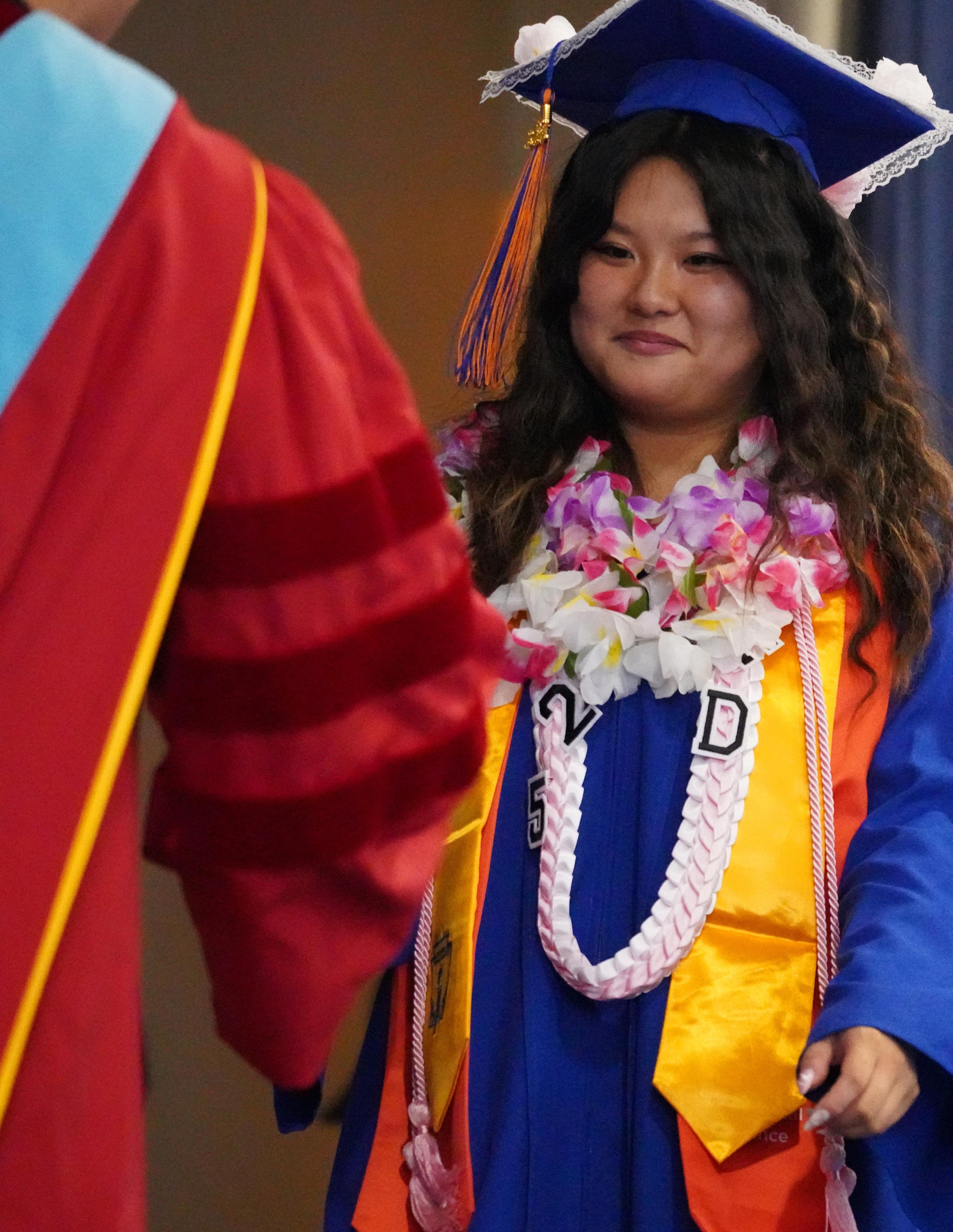
“[Leadership is] facilitating how we work together. I’m not making decisions for everyone, but trying to create compromise across everyone’s opinions.”
building her confidence in front of groups of people.
When it comes to her leadership roles, Cecilia says, “Something that I cherish about being a leader is that you meet people you might not talk to every day and get to know them.” She points out that leadership doesn’t mean that she always has to be the one talking or doing things: “It’s facilitating how we work together. I’m not making decisions for everyone, but trying to create compromise across everyone’s opinions.”
This fall, Cecilia will be attending Stanford University. Although she would like to become a dentist, she loves that “Stanford gives you a lot of freedom in your major. I am very openminded to whatever ends up feeling right.”

This past spring, Christian Thewodros ‘25 was thrilled to learn that he had been accepted to Macalester College in Saint Paul, Minnesota.
In eighth grade, he had been inspired to apply to and attend SJND by Alazar Hailu ‘21, a family friend and important role model. Now, as Christian was preparing to graduate from SJND, Alazar was preparing to graduate from Macalester.
It was, Christian says, “A full circle moment.”
Both Christian and Alazar’s families immigrated to the United States from Ethiopia in the mid-2000s. As a first-generation college student, Christian attended SJND through the Achieve Program, which he believes has helped him both academically and personally.
“The little things [Achieve] requires you to do change your life,” Christian explains. “Every four months, there is a meeting. Even freshmen students speak at those meetings and present essays that Achieve has them write. Every time you present, you get experience with public speaking… Even small things like writing in the planner… staying focused and organized. Doing these things for the past four years has changed me.”
The transition to high school from middle school wasn’t easy. Christian had spent most of seventh and eighth grade online during the pandemic and had
assumed high school would largely feel the same. He’d also just returned from spending a summer in Ethiopia. Christian describes how he “landed in the U.S. and then the next day was freshman orientation. Things were so ‘innocent’ in Ethiopia [compared to in the U.S.] In the U.S., people presented themselves as being all cool and nonchalant and not caring about grades, but then once they were in the classroom, you found out they were] totally smart. It was hard to wrap your brain around.”
“The little things [Achieve] requires you to do change your life. ... Even small things like writing in the planner... staying focused and organized.”
Eventually, Christian found his feet. Not only did his focus and diligence gain him admission to his first-choice college, but he also developed several new interests, including data science, which he has pursued through an AP course, as well as an internship at UC Berkeley. At Macalester, Christian hopes to major in data science and minor in economics.
As he considers his future, Christian recalls a speech given by Barbara Bass Bakar, founder of the Achieve program, in which she said, “Always pay it forward.” According to Christian, “Those words stuck with me. I have a drive to help as many people as possible with whatever I am doing just as [Achieve] first helped me.”
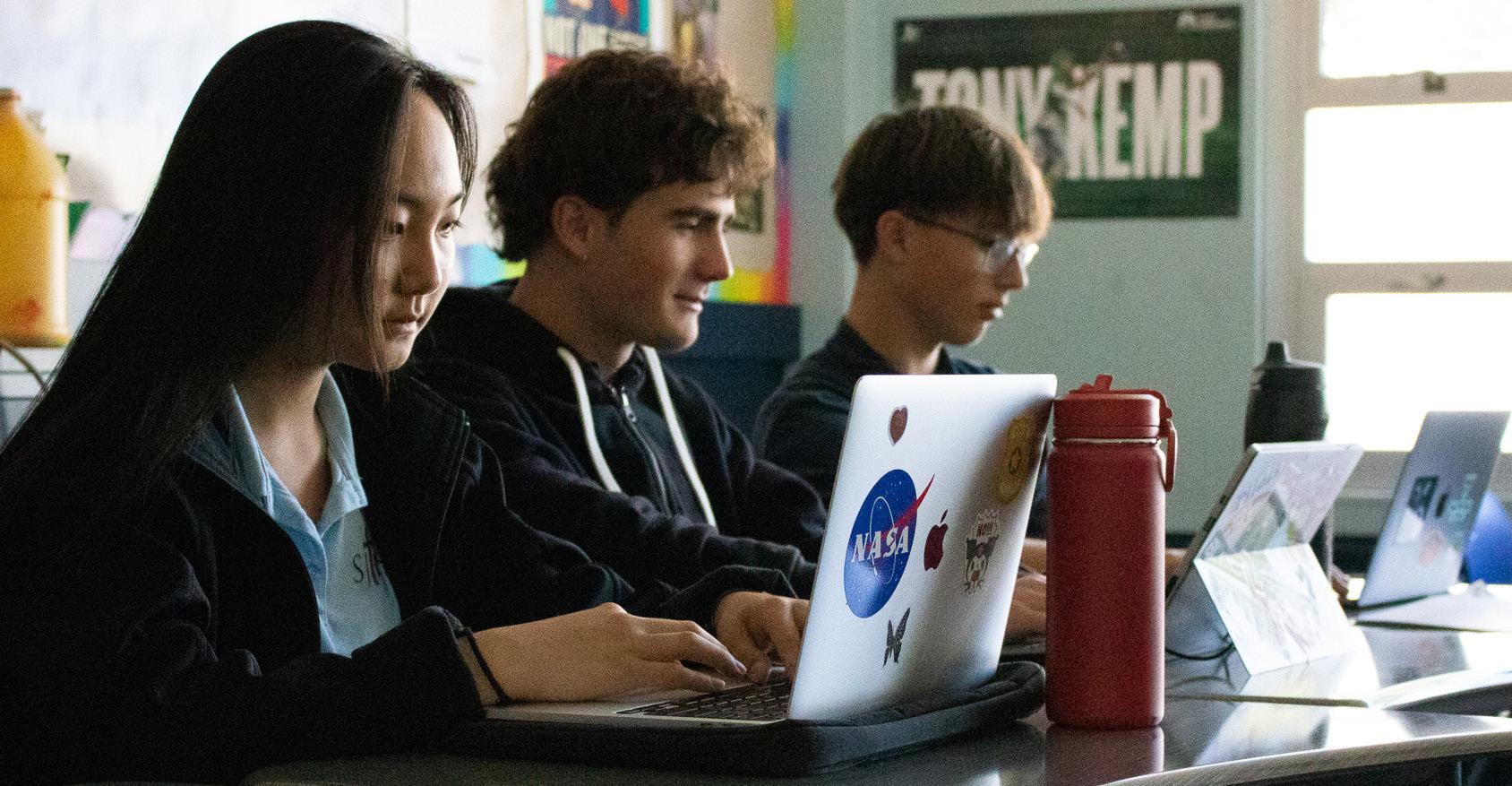
When considering a future career, there are four questions we should be asking ourselves:
What do I love doing?
What am I good at?
What does the world need?
How can I get paid?
All four questions deserve equal consideration, but most people simply focus on getting paid, which doesn’t necessarily bode well for career satisfaction.
According to Principal Steve Kim, students need opportunities to explore different career paths before committing to one; this could be as low-key as having coffee and asking questions of an adult in a particular field, or as organized as a summer job or internship. What’s most important is that students have the chance to learn about a variety of fields, so that they can get a better idea of the types of tasks and environments that appeal to them—as well as those that don’t.
This is the idea behind the school’s new mentorship program, which College and Career Counselor Elizabeth (Liz) Hunter is working to develop. Liz explains that the goal of the program is to build relationships: “We want students to talk to people, hear what [a particular career] is like. We are looking to connect our students with alumni, as well as people in our local community, who feel that they could be mentors.”
Bringing different generations together can help young people to visualize the entirety of a career path, not just
one or two steps. As students build relationships with their mentors and their knowledge grows, they can get better at asking questions that relate to their interests and can point them towards opportunities. Mentors can then help by directing students to some of those opportunities, such as internships or job openings. In some cases, after building relationships with SJND students, mentors have even designed specific programs for them.
John Marshall, a West Oakland firefighter and instructor, has been mentoring students at SJND for the past two years, an experience that inspired him to create a biomedical internship just for the SJND community. Next year, six students will be working with John to learn how to do CPR and first aid, how to care for wounds, and how to measure EKG and vitals.
The Mercy & Medicine internship, through which SJND students have learned about working with communities facing homelessness and food insecurity, developed similarly through the school’s pre-existing relationship with Dr. Caren Vance Gee.
Although internships are highly valuable to SJND students, not every career professional is equally placed to offer one. Yet, as Principal Kim notes, events like SJND’s Career Day demonstrate that there is interest in giving back. Mentorship is a valuable first step; it provides the advice and guidance that can eventually support students in gaining experience.
If you have questions about SJND’s mentorship program or are interested in being a mentor, please email Mentorship@sjnd.org.
If you want to learn how to do something, you could start by signing up for a course. Or you could just leap in and attempt to do the thing you want to do, learning from your mistakes along the way.
This past semester, four SJND freshmen chose the latter strategy as they worked together to code and design an online game.
Initially, Esther Ward ‘28 came across the opportunity through Hack Club (hackclub.com), a nonprofit network of computer science clubs and makers around the world. Each local club is student-led and exists to teach its members how to code and work together to create their own projects. One of the draws for participating in these clubs is the “hackathon”, a collaborative coding event where participants have a set amount of time (for example, 24 hours) to build a specific product.
The hackathon that caught Esther’s eye was a little different. Playfully called “Juice” by its organizers, this hackathon gave participants 2 months to spend at least 100 hours building a 30-minute, language-less game. Those who met the requirement would receive a $750 stipend to travel to Shanghai, China, and contribute to a pop-up gaming cafe, where locals could wander in off the street to play their game.
As Esther explained in an article that she wrote for Pilot Island, she wasn’t sure whether she could
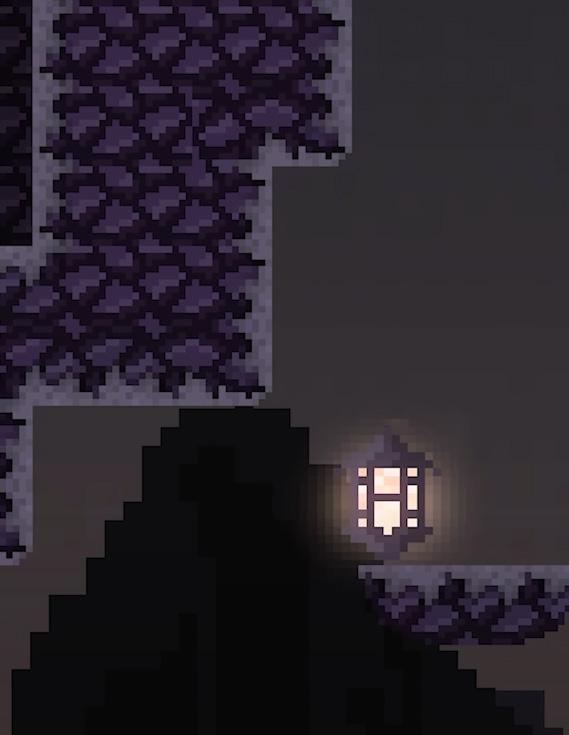
complete 100 hours on the project, but if she did, the reward was guaranteed: “[Juice states that] everyone who completes the challenge gets to go. Which meant I could make it happen.”
It didn’t even matter that she had never done anything like it before. According to Esther,

“I’ve learned the most by biting off more than I can chew on a project, learning as I go, and looking things up.”
But recognizing that a few friends would make the project more enjoyable, Esther quickly recruited Luca Salloum ‘28 to assist with coding and Layla Salloum ‘28 and Peter McNish ‘28 to design the graphics.
Unsurprisingly, the team discovered that developing a new game was not easy. As Luca puts it, “You’re left in the dark about how to apply what you know to create and change things.” In addition to Esther and Luca’s relative inexperience with coding, Layla and Peter were tasked with designing a game that could not include language, and thus no instructions: the images had to speak for themselves.
Everyone had to learn through experimentation.


Using the programming language Godot Script, Luca and Esther spent their first 50 hours coding all of the basic features, such as backgrounds, character movements, camera movements, animations, and adding or removing items from the inventory. After all that work, they only had seven minutes of playing time. Scaling it out required an even bigger learning curve as the two coders realized they would need to continually figure out how to create unique features to keep things exciting.
The group also faced the challenges of balancing their schoolwork with the incredible amount of time required by the project, as well as recouping when they lost work that they thought they had saved. For this reason, they decided to put the narrative aspect of their game on hold to focus simply on the actions required to complete each level.
The end product, “Dust and Dawn,” is a game inspired by the games “Monster Sanctuary” and “Hollow Knight” and by the Studio Ghibli film Spirited Away. The aesthetic is dark, haunting, and pixelated. In this dead and polluted world, a soot sprite attempts to clean things up while also coming to the aid of the other creatures it encounters. The game offers four levels for 30

minutes of playing time. Although it appears simple on the surface, “Dust and Dawn” is a testament to the hard work, creativity, and perseverance of these four students.
Having spent over 300 hours combined building their game, the team succeeded in meeting the requirement to travel to Shanghai. Although Layla and Peter ended up having other commitments that prevented them from going, Esther and Luca crossed a second new frontier: traveling internationally without parents!
Once a Hack Club member met them at the airport, however, any initial nervousness disappeared to be replaced by excitement. Over 90 students from 23 different countries gathered together to explore the city, work on projects, share their games, and receive feedback from local kids as well as professional developers.
Communication with the other Juice participants was surprisingly easy; most of them spoke English as a second, third, or even fourth language. Although speaking English wasn’t always an option with Shanghai locals, both Esther and Luca were pleasantly surprised to discover that translator apps were widely accepted — even encouraged — as an efficient way to communicate.
This proved particularly useful when trying to guide people through “Dust and Dawn” at the pop-up gaming cafe. Although the game was
meant to be language-less, Esther points out, “that doesn’t mean we do a good job of [using emojis to explain] to the players what to do.”
One of the most memorable local gamers was a little girl who spent several hours trying out all of the games. Despite communicating with her mostly through a translation app, Esther felt a strong sense of connection: “We were so different from each other but still sharing this joy of videogaming.” It was particularly heartwarming at the end when the little girl concluded that “Dust and Dawn” was her favorite out of all the games.
According to Luca, most people who played the game were very complimentary, feedback that he appreciated since “there is always the question of how your game will be received in another country with a different audience. Even if others had more complicated coding, our game still stood out just because of how it looked.”
The primary criticism the game received from the tech professionals who played it was that it needed better motion controls. Now back home, the team hopes to continue improving the game and develop its narrative aspects.
As Esther wrote in her Pilot Island article,


Scan to watch videos about everyone’s adventure in Shanghai!

“Building is about learning, and since learning was our goal, however scrappy our game is, we succeeded.”

The SJND Admissions Department has found new leadership in Joe DiGiulio ‘16 and Haley Graybeal ‘19. This past year, Joe and Haley, Director and Assistant Director of Admissions, respectively, have overseen the admissions process from start to finish, a process that Joe emphasizes is not about “numbers” but about “looking for kids who are going to be a great fit.”
Haley describes how her time at SJND instilled her with the ability to think critically and self-advocate; in a small school
environment, students can’t get “lost.” The fact that she and Joe are able to share their background as SJND students has helped to draw in prospective families because “they know we’re not just selling a ‘product’ but speaking from experience.”
Joe acknowledges that while there have been many surface-level changes since he was a student at SJND, “the mission and sense of community are the same.”



The students at Notre Dame High School for girls were required to wear a uniform that included a pleated skirt, collared blouse, sweater (choice of pullover, cardigan, or vest, not all of which are pictured here), and white tennis shoes.
St. Joseph High School for Boys had a dress code, but not a uniform. Boys were expected to wear slacks (no denim), a collared shirt (always tucked in), and dress shoes. On special occasions, such as masses (or yearbook photos such as the one above), the boys were also expected to wear a tie.






While the essential requirements of the girls’ uniform and boys’ dress code remained largely the same through the 50s, 60s, and 70s, the styles of the various items evolved with the times.
This past year, SJND’s uniform policies have been a major topic of discussion. Although the current students have a larger number of clothing options than students in the past, the sheer number of styles—of, for example, khaki pants—available to purchase has led to inconsistency that it was deemed important to
address. Now that the student handbook contains clearer wording and specifications (turns out “khaki” should be considered a color, rather than a style), both teachers and students are better able to identify what is and is not uniform-compliant.


Since the founding of Notre Dame High School for girls and St. Joseph High School for boys, students have always been required to adhere to a certain standard of “professional” dress, but ideas of what that should look like have evolved throughout the years.

In 1985, when St. Joseph and Notre Dame consolidated to form Saint Joseph Notre Dame High School, there was an initial consensus that things would remain the same: a dress code for boys and a uniform for girls.
In the mid-1990s, however, the school shifted to a uniform for both genders that included navy blue or khaki pants, polo shirts, and sweaters. Excitingly, girls now had the option of pants as well as a skirt, and in the early 2000s (when this photo was taken), students of both genders were permitted to wear shorts in warm weather.





By the late 2000s, sweaters had been replaced with sweatshirts. Following the COVID pandemic, the school also introduced “SJND outerwear”: pullover jackets and light windbreakers with the SJND logo.


It’s the end of an era at SJND. After 25 years supporting students’ mental health and academic success, counselor and erstwhile theology teacher John Gunty is retiring from school life.
Those who had the pleasure of knowing John won’t be too surprised to hear how he was recognized for his years of service. As he revealed in his Commencement address, “[The school] gave me a brand new Toyota. Generous, right?” Then, after a pause, he pulled a longeared plush figure from his graduation robe and continued, “My new toy Yoda! Okay, it’s not a car, but it’s cool, right?”
And from there, John catapulted into a farewell speech referencing the Holy Spirit, gratitude, nature, Jesus Christ, software, and, of course, Yoda. His final message to graduates: life is a gift filled with mystery that we cannot always understand, but which we can navigate with support from others; we also have a purpose in life, and that is to learn who we are and to love one another.
It was the epitome of John’s dual nature, goofy on the surface, yet profound in its depths, and a reflection of why students and colleagues have been drawn to him over the years—as well as why they will miss him. Behind the infamous “dad jokes,” the dozens of toy Yodas in his office, and the contentious Oakland Raiders jacket, John worked with people and ideas in ways that prioritized connection and groundedness.
Learning Services Counselor Maryanne Stehr explains John’s impact on the school community this way: “[Yoda says,] ‘To be a Jedi is to face the truth, and choose. Give off light, or darkness, Padawan. Be a candle, or the night.’ [John is] a candle. [He has] lit the path for so many of us.”
According to John, his interest in theology and spirituality has always stemmed from his desire to cultivate personal growth and meaning, rather than simply presenting and supporting doctrine. His counseling is informed by transpersonal psychology (which is influenced by many spiritual traditions), and he believes that “we have a purpose, so I want to nurture that.”
Although teaching runs in John’s family (his father and two of his brothers were teachers), he admits that it wasn’t necessarily where he had planned to end up: “The teaching part definitely chose me. I didn’t necessarily want it [prior to trying it out].” But after graduating from Northwestern University with a B.A. in Education, an opportunity for an internship at the Christian Brothers Retreat House in Napa Valley beckoned, and “kaboom” (as John expresses it). It was there that he fell in love with the ways in which spirituality and psychology overlap and embarked on his journey working with adolescents.
“[Yoda says,] ‘To be a Jedi is to face the truth, and choose. Give off light, or darkness, Padawan. Be a candle, or the night.’ [John is] a candle. [He has] lit the path for so many of us.”
Following his time at the retreat house, John went on to receive a Master’s in Counseling Psychology from John F Kennedy University as well as a Pupil Personnel Credential from St. Mary’s in Moraga. In all, John has taught theology, coordinated parish youth ministry programs, and counseled students at eight Catholic parishes and schools. It wasn’t until
1998 that he joined the faculty at SJND, teaching a single theology class while also working as a counselor. After a brief detour to pursue marriage and a new life in 2001, John eventually returned to teach and counsel students in 2003, ultimately becoming Director of Counseling in 2006.
Over his 25 years at SJND, John has created or initiated many of the important programs, groups, or productions that the current staff, faculty, and students simply take for granted. This includes the college counseling program, which he led as the first college counselor at SJND; the “Counselors in the Classroom” (CIC) program, which offers academic guidance as well as socialemotional learning; and the counseling program for students with learning differences. He was also the first person to create a small counseling group for gay and bisexual students, now known as the Us’s Club for LGBTQ+ students and their allies.
When asked what’s kept him at SJND all these years, John is quick to respond, “The culture and the students. This population is smart, hardworking, interesting—and they’re good people. … I’m going to miss my teammates [in counseling], casual conversations with students, bugging each other and talking about nothing, just being around teenagers.”
However, although John is leaving SJND, he is not officially retiring quite yet. Instead, he will be creating a part-time private practice through which he can continue to counsel and support teens and young adults using a somatic mindfulness approach called Hakomi.
“Be kind to yourself,” John advised the class of 2025. “That is one of your most important life purposes. And, as I know well, it is a job that never ends.” The same can be said, perhaps, of John’s desire to help young people locate meaning in the world.
“This population is smart, hardworking, interesting— and they’re good people. … I’m going to miss my teammates [in counseling], casual conversations with students, bugging each other and talking about nothing, just being around teenagers.”


NThat day finally came on Saturday, May 24th, 2025. The ordination was held at the Cathedral of Christ the Light in Oakland, California, over 3,000 miles from El Salvador, where he had grown up. In some ways, it had been an unexpected journey; in others, it felt like it was the path he had been walking all along.
As a child, Fr. Santamaría lived on the same block as his parish. He came from a devout family and would attend daily mass and sing in the choir. He even attended a youth group called Missionary Childhood that would evangelize other children. As he recalled for his vocation story for The Catholic Voice, “We were full of joy because we were witnesses of Jesus Christ. We were sent to the houses two by two, just like the disciples at the time of Jesus, and we would ask the parents to allow us to talk to their children. The idea was to invite the other children to come to Church and to know Jesus.”
Despite Fr. Santamaría’s early relationship with God, the priesthood had not been part of his childhood plan. Instead, he had studied civil engineering at the University of El Salvador and worked at a construction company building houses. The traditional path of career and family seemed to beckon.
Yet, Fr. Santamaría continued to feel like he needed to make more room for God in his life. He wrote in his vocation story, “Prayer is not a monologue. To pray is to have a conversation with God where I speak, and He listens. But, most importantly, where He speaks, and I listen.” As Fr. Santamaría’s

priorities started to shift, he heard God calling to follow Him. Finally, at the priestly ordination of his friend, God spoke to him through the readings he heard at Mass: “You are my son; today, I have begotten you.”
Fr. Santamaría realized, “The Lord didn’t want me only to build physical houses and concrete roads for others. He wanted me to build spiritual houses for His people and the road that will bring people back to Him through the sacraments.”
However, two years after quitting his job and joining the seminary in El Salvador, Fr. Santamaría was presented with another fork in the road: his childhood pastor suggested that he apply to the Diocese of Oakland, California. Although it wasn’t what he had anticipated, Fr. Santamaría traveled to the Bay Area, where he met with Bishop Barber and was welcomed to the Diocese of Oakland to continue his studies at St. Patrick’s Seminary in Menlo Park.
In May 2024, after graduating and being ordained a deacon, he was assigned to St. Joseph Notre Dame High School, where he also became a theology teacher and campus minister— again, not what Fr. Santamaría had planned for.

“The Lord didn’t want me only to build physical houses and concrete roads for others. He wanted me to build spiritual houses for His people and the road that will bring people back to Him through the sacraments.”
“It was challenging at the beginning,” he admits. “Being a teacher and campus minister was a whole new world to me. I had to learn and start from the bottom [but] I received a lot of help from the faculty and staff at SJND.”
This past year, Fr. Santamaría taught Hebrew and Christian Scripture to sophomores while also guiding students in their spiritual life through liturgies, retreats, and prayers. Additionally, he started a new confirmation program with 24 students who received the sacrament of Confirmation in May.
One year after he was ordained as a deacon, Álvaro Santamaría became Father. Grateful and humbled by his experiences, he stresses that “I wouldn’t change the time I have spent with my students for anything in this world. … My time at SJND has changed the way I look at the priesthood and the different ways I can minister to God’s people, in this case, the youth.”
Fr. Santamaría will continue to serve the parish and teach at SJND through the 2025-2026 school year.
This year, members of the SJND community have been reimagining ways to give back to the school. From finding new avenues for volunteerism to inviting alumni to take on mentorship roles to developing long-term relationships with donors, the intention is to encourage all stakeholders to recognize the impact they can have on future students.
It was this impact goal that Sherry and Tim Scott had clearly in mind when they re-energized an element of SJND’s strategic plan to garner greater investment involvement from large donors. The plan’s core objective is to provide consistent and predictable cash flows to invest in the school for the benefit of the broad SJND community. It grew out of substantial input from key SJND influencers and existing large donors with the intent to provide the best-in-class learning environment to serve the SJND community well into the current century—a learning environment that is dynamic and agile enough to stay ahead of the multiple disrupting forces present in the educational systems today.
Having taught theology at SJND for 6 years, Sherry Scott has long appreciated the kindness, commitment, and diversity of its student body. When her husband Tim joined the school in 2024, he was equally impressed. Importantly, in his role as Director of Finance, he also had an indepth understanding of the financial needs of the school, the largest of which remains the same every year: tuition assistance and capital improvements.
Approximately two-thirds of the Class of 2025 received financial aid at various levels. This number represents students across all walks of life at SJND: scholarathletes, budding performers and musicians, STEAM inventors, artists, debaters, and leaders on CLT, ASB, ALT, and CMEB. Of the 6 students considered for the roles of class valedictorian and salutatorian, 5 received some form of
tuition assistance while attending SJND.
At the heart of the school’s mission, tuition assistance doesn’t just benefit the students who receive it. It ensures a diverse community that allows for all students to experience perspectives different from their own, an education that can be transformative on multiple levels across our community.
The SJND Future Fund emerged from a strong desire of involved donors and influencers to give back while also inspiring others to pay it forward. The name of the fund says it all. Rather than fundraise for a prescribed amount, the SJND Future Fund is meant to encourage multi-year commitments from large donors to secure SJND’s position in the community for an indefinite future. In the decades to come, it’s hoped that this current legacy-building period will be viewed as a historical moment just as impactful—if not more—as the consolidation of St. Joseph and Notre Dame high schools, profoundly changing the lives of SJND students and the community at large.
The Future Fund is an important part of a broader initiative to create a stronger sense of purpose and community among current students, alumni, and other important stakeholders through opportunities to “pay it forward” that include volunteering and mentorship. In particular, the school hopes to inspire a younger generation to consider how their SJND experience shaped them and how they, in turn, might impact the students who will come after them.
At the heart of the school’s mission, tuition assistance doesn’t just benefit the students who receive it. It ensures a diverse community that allows for all students to experience perspectives different from their own, an education that can be transformative on multiple levels across our community.

It’s hard to believe that Cathy Fitzgerald (AKA “Ms. Fitz”) has been teaching part-time at SJND for the last eleven years.
To clarify: it’s not the fact that Cathy has been at the school for over a decade that is surprising (in fact, many people assume it’s been longer); it’s that all these years, she supposedly has only been devoting part of her time and energy to SJND.
Not only has Cathy taught nearly every class in the English department curriculum (and arrives at school at 6 am to do so), but she’s also renowned for all the extra activities she plans and orchestrates for her students: coordinating the school’s Youth Vote for every primary and presidential election in the last decade; cajoling famous authors and writers to speak at the school; buying up every last box of sidewalk chalk at Target so that she and her students can engage in “guerilla poetry,” deftly chalking lines from Langston Hughes or Emily Dickinson on the asphalt in the quad, and then disappearing like ninjas…
As valedictorian Tiona Truong ‘25 humorously alluded in her graduation speech, Cathy frequently told the class of 2025 that they were “extra”, meaning over-the-top, excessive, and

bold—but that same adjective could be applied to Cathy herself.
Anyone who has ever sat in Cathy’s classroom is aware of her “stage presence”, or, as Joy Chang ‘24 describes it, “the unapologetically authentic personality she flaunts.”
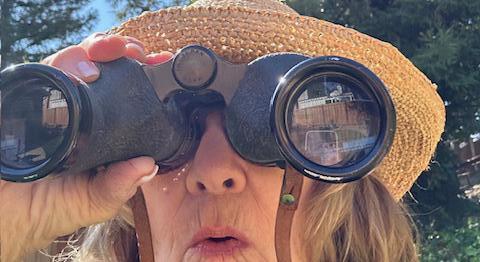
While this flair for the dramatic lights up her classroom and engages her students, it is also what attracted Cathy to her first career choice in theater. As she recalls, “I was going to be a serious actor… [But that plan] had to be shelved when I had an accident during the summer after high school graduation and sustained head trauma that left me with compromised hearing and balance.” After some soul searching, she turned to teaching.
As she prepares to retire from SJND, Cathy reflects on the sense of purpose that her
students have provided to her, saying, “Teaching was not my first career choice, but it was the right career choice for me. … I experienced a newfound energy watching my charges discover some new idea or celebrate a skill improved or mastered. My classroom became my stage with my students becoming my fellow actors…and sometimes my audience.”
Prior to teaching at SJND, Cathy worked for over 38 years as a teacher and administrator for the Antioch Unified School District. In fact, when she left Antioch Unified, she was “supposed” to be retired, but, as Cathy explains, “I realized that when I looked back at what had drawn me to secondary education my most recent memories of my time spent in Antioch were all about board meetings, site budget meetings, and developing teacher trainings. My memories of what I had done in the classroom seemed to have been erased from my memory…and I hated that.”

“[SJND] gave me the opportunity to get to know so many incredible young people who would be taking over the stewardship of this planet when I am beyond taking care of myself…let alone a planet.”
The solution was to return to teaching in the classroom “part-time”. Cathy has particularly loved being part of SJND because “It gave me a front-row seat watching students improve their reading and writing skills. It gave me the opportunity to devise lessons that let my students’ collective and individual creativity take those better-developed skills to another level. It gave me rallies and assemblies and sporting events. And as a small school, it gave me the opportunity to get to know so many incredible young people who would be taking over the stewardship of this planet when I am beyond taking care of myself…let alone a planet. The selfish part of teaching is that we are preparing our students to take care of us individually and collectively after we have left the profession. The students that I have had the privilege to work with will take care of me… will take care of all of us…well.”
As for what retirement holds, let’s just say, not a lot of “retiring.” In addition to continuing on in her role as adjunct professor of English at Diablo Valley College (yes, she’s also been doing that part-time since 1991), Cathy will be looking after her grandchildren while also planning to return to SJND a couple of days a week as an academic support coach. According to Cathy, “This community has given me so much in the best and worst of times. … I cannot bear to leave it without some kind of limited return.”
Casey Macatangay Bennett ‘75
Son of:
Wilma Macatangay
Brother of:
Michael Macatangay ‘91(Deceased)
Gracia M. Hofmann ‘92
Benedicto Macatangay ‘92
Charles Carattini ’72
Spouse of:
Carolyn M. Carattini
Brother of Alum:
Caprice Carattini ‘73
Helen McCarthy Carroll ’40
Spouse of:
Agnes Marcheschi
Mother of Alum:
Janice Carroll ‘77
Grandmother of Alum: Kathleen Carroll ‘19
Sofia Close ‘73
Carol Gates Dean ‘66
David Lillevand ’55
Brother of:
Peter Lillevand ’57
William McDonald ’53
Brother of:
Joanne McDonald Wedemeyer ‘50 (Deceased)
James Stonehouse ’55
John Rusca ’64
Carlo Di Ruocco
Father of Alums:
Laurence Di Ruocco Zambrano ‘82
John Di Ruocco’85, Luigi Di Ruocco ‘94.
Grandfather of Alums:
Francesca Zambrano ‘10
Alessandra Zambrano ‘13
Bruno Zambrano ‘19.
Fiore Marcheschi
Spouse of:
Agnes Marcheschi
Father of Alums:
Linda Marcheschi-Teplitz ‘78
Paula Maria Marcheschi ‘87
Michael J. Marcheschi ‘79
Mary Ann Quittman
Mother of:
Anne (Davis) Stainback ‘88



ADDRESS SERVICE REQUESTED